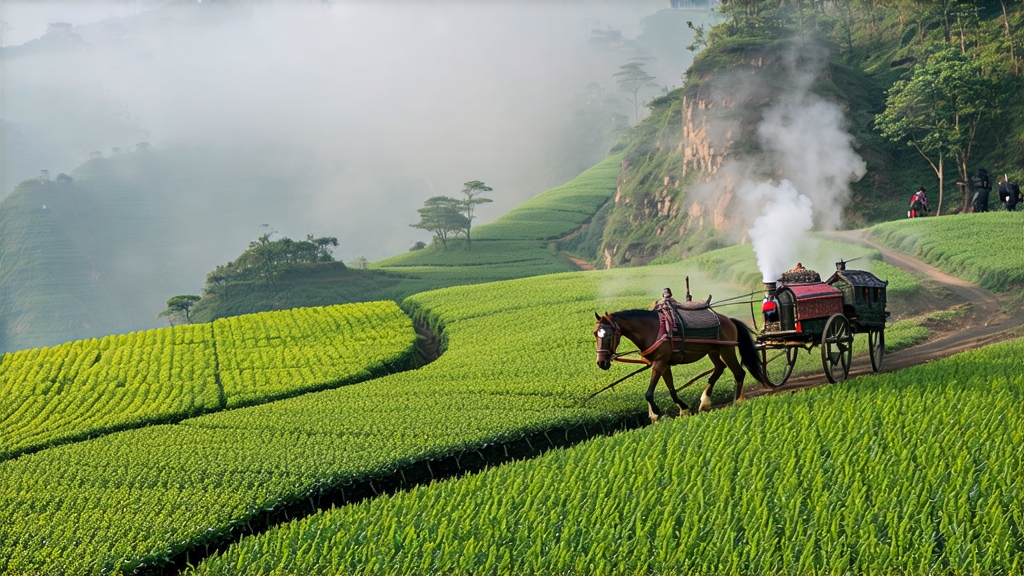
Tucked into the cloud-veiled folds of Hunan’s Xuefeng Mountains, Anhua Dark Tea has spent five centuries perfecting the art of patience. To the uninitiated it looks like humble compressed earth—dense bricks, coarse leaves, the occasional amber fleck of a “golden flower.” Yet when hot water meets this seemingly inert matter, the tea awakens, releasing a mellow, resinous liquor that tastes of wet pine, dried jujube, and the cool breath of subterranean cellars. Anhua is not merely a beverage; it is a living archive of Ming-dynasty trade routes, of ethnic Miao and Tuja tea masters, and of microscopic fungi whose quiet metabolism turns green leaf into liquid antiquity.
The county of Anhua, bisected by the Zi River, began producing dark tea in the 1520s when imperial demand for border-trade tea surged. Caravans leaving the wharves of Jiangnan needed a tea that would survive the 3,000-kilometer trek to Lhasa and Kashgar without molding or losing value. Local processors discovered that piling, humidifying, and re-firing the leaf not only stabilized it but also mellowed its harshness. By the Jiajing era, Anhua bricks were currency among horse-trading garrisons, and the Qing court codified its tribute status in 1595. The Tea Horse Road, that stone artery of commerce and culture, still echoes in every earthy sip.
Today Anhua Dark Tea is classified into four primary shapes, each with its own micro-ecology. Brick tea (Zhuan Cha) is the most iconic—rectangular 2-kilogram blocks stamped with the auspicious characters “Gong Ting” or “Qian Liang.” Roll tea (Juan Cha) is a tightly wound 50-meter scroll weighing 36.25 kg, the world’s largest single tea artifact; it requires two men and a bamboo spool to unwind a single portion. Cake tea (Bing Cha) resembles Yunnan pu-erh but carries a lighter, sweeter note, while loose-leaf “San Cha” is favored by Hunanese grandfathers who like to watch the leaves dance in a glass jar. Within these shapes, the presence or absence of Eurotium cristatum—known to traders as “golden flowers” (Jin Hua)—creates further nuance. The fungus blooms only when temperature, humidity, and leaf chemistry align, freckling the brick with canary-yellow specks that deepen the tea’s camphor sweetness and add a lingering dried-apricot finish.
Crafting Anhua Dark Tea is a dialogue between human intent and microbial whim. Picking begins in late April when the first spring mists lift; only one bud with three or four mature leaves is taken, ensuring enough stem to fuel slow oxidation. The leaf is withered on bamboo mats for six hours, then “killed-green” in a wok heated to 280 °C for exactly 90 seconds—long enough to rupture enzymes yet preserve leaf integrity. While still warm, the tea is rolled into tight curls that crackle like autumn twigs. The critical step, called “wet piling” (Wo Dui), follows: leaves are heaped 70 cm high, sprayed to 28 % moisture, and covered with hemp cloth. Inside this composting mound, thermophilic bacteria raise the core temperature to 55 °C; workers turn the pile every five days, aerating and re-wetting, coaxing the leaf from green to russet over twenty-five days. Once the desired “fish-eye” amber infusion is achieved, the tea is dried in pine-fired ovens whose smoke imbues a subtle resinous note. Finally, the leaf is steamed and compressed under 50-ton hydraulic presses, then moved to humid underground cellars for the slow post-fermentation that can last anywhere from one to fifty years. In the deepest tunnels, bricks stacked during the Korean War still sweat, their wrappers brittle with age, their cores alive with golden spores.
To brew Anhua Dark Tea is to practice temporal alchemy. Begin by awakening the brick: insert a slim tea needle along the natural fracture lines and lever out 5 grams—enough to fill a small gaiwan or 150 ml Yixing pot. Rinse the leaf for five seconds with water just off the boil; this first flash not only washes away cellar dust but also coaxes the compressed layers to loosen. The initial steep, 10 seconds, yields a pale citrine liquor reminiscent of dried longan